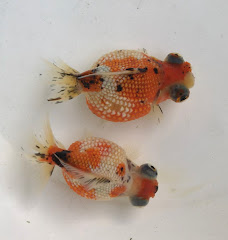稀罕生趣,雷同殺藝
~ 靈感源自明代魚盆銘文
Rarity sparks joy, replication murders art.
~ Inspired by Ming Dynasty fishbowl inscriptions.
 |
4-bubbles bred by Tian Zhuang ( (田庒戲泡) displayed
during the CIPS Guangzhou 2024.
Picture courtesy of Mr. Alvin Lim
|
What began as a humble crucian carp in ancient China has blossomed into one of nature’s most extraordinary canvases. Since the Jin Dynasty 晋朝 (265–420 AD), when the first golden mutant crucian carp emerged, we’ve witnessed an evolutionary ballet. With a remarkable 100 chromosomes — more than double our human count, the goldfish’s genetic symphony erupts into dazzling mutations under different environments, yielding endless variations that have captivated civilizations for centuries.
 |
selectively bred
swordtails with compact body |
While most aquarium fish, such as swordtails, tetras and gouramis display modest variations like elongated fins or compact bodies, goldfish explode with radical transformations. Every feature mutates spectacularly: from bulging eyes, pearl-like scales, dorsal-less egg shapes, crown-like head growths, and tails like butterfly spreads. Even their mouths reshape, as seen in the Ryukin’s sharp beak. One of the most unimaginable mutations, the throat sac of the Four Bubbles, swells into hypnotic, glass-like orbs with every breath it takes.
breeding and importing goldfish over the years, we have experienced our fair share of mutations too
Humans became co-creators - enhancing these spontaneous mutations through selective breeding, artfully combining different traits like a master decorator assembling nature's finest ornaments. Sometimes a single fish emerges bearing multiple marvels: pearlscale with dragon eyes and pompoms, celestial eyes paired with lionhead growths, or Orandas with broad butterfly tails.
 |
a rare mutation
of the pectoral fin |
Herein lies their magic. While ornamental fish like guppies are "dissected" in competition — stripped into segments, each trait scored in isolation. But goldfish refuse such reduction. Their beauty lives in the whole: A lush head wen may crown one fish elegantly yet overwhelm another. We do not tally their parts; we feel their balance. Like judging a face not by nose or brow alone, but by the silent music of their harmony. With forms too diverse to catalog, each human or goldfish becomes a unique testament to nature's creativity.
Goldfish mirror humanity’s dance with nature; our attempts to shape it, and our humility when it surprises us. As Japanese breeders say, "The perfect goldfish doesn’t exist." Yet this imperfection makes them perfect. Even breeding successes reveal paradoxes: the Red Cap Oranda, once revered for its rare red crown, lost much of its allure when it can be bred true and mass-produced to a high degree of consistency. Scarcity, it seems, fuels wonder and uniformity extinguishes it.
 |
The Red Cap Oranda
|
The art of goldfish appreciation teaches us that life’s most breathtaking creations emerge not from rigid control, but from the beautiful tension between human intention and nature’s boundless imagination. In each unique specimen, we find a masterpiece written in scales and fins — a testament to the wonder that unfolds when we collaborate with, rather than conquer, the natural world.
Yet today’s market tells a narrowing tale. While a handful of goldfish varieties dominate aquariums worldwide, few realize that over 300 documented and undocumented strains exist. Ancient breeds, like the Celestial, the Tigerhead, or the Phoenix are dismissed as "less regal" despite their storied and ancient lineages that have endured centuries longer than their commonplace counterparts.
Some rare exotics imported over the years
 |
Our concoction of Pompom,
Dragon Eyes and Pearlscale |
At JuzFish ArtQuatics, we have quietly championed these overlooked treasures for years. By curating rare, high-quality specimens of exotic varieties, we hope to rekindle appreciation for goldfish diversity beyond the familiar. For in their forgotten forms, sculpted by time and refined by history lie masterpieces of living art, waiting to be rediscovered.
Stay tuned for our limited retail opening announcement as we present some of these exquisite specimens at their most resplendent. 😉
To get timely updates, subscribe to our telegram channel :
https://t.me/juzfishart
or follow our Facebook page:
https://www.facebook.com/juzFishArtQuatics
juzFish
the art of fish






















